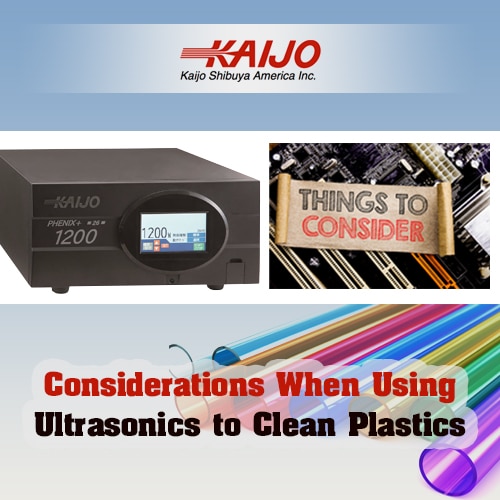Considerations When Using Ultrasonics to Clean Plastics
November 7, 2022
 Whether using ultrasonics is the best choice for cleaning plastic parts depends on the type of plastic and the nature of the contamination. Hard, dense plastics are easy to clean with ultrasonic cleaners, but choosing the right frequency and configuration is still important. Parts made from soft or light plastics need special measures for ultrasonic cleaners to clean them effectively.
Whether using ultrasonics is the best choice for cleaning plastic parts depends on the type of plastic and the nature of the contamination. Hard, dense plastics are easy to clean with ultrasonic cleaners, but choosing the right frequency and configuration is still important. Parts made from soft or light plastics need special measures for ultrasonic cleaners to clean them effectively.
Even when the type of plastic is not ideal for ultrasonic cleaning, ultrasonics may be the only solution. Parts with complex shapes, interior openings, or dead-end holes can often only be entirely cleaned with ultrasonic technology. An experienced manufacturer of industrial ultrasonic cleaners can recommend the best solution for specific plastic parts.
Soft Plastic Takes Longer to Clean
The intensive cleaning action delivered by low-frequency ultrasonic cleaners can damage parts with soft surfaces. Higher-frequency cleaners produce smaller cavitation bubbles in the cleaning solution. This means that the scrubbing action of the bubbles when they burst is less intense. These higher frequencies avoid surface pitting and damage to delicate part structures. Because the cleaning action is less intense, cleaning can take longer.
Flexible Plastics May Absorb Ultrasonic Cleaning Power
When the scrubbing action of the cavitation bubbles hits a rigid surface, it dislodges any contaminating particles adhering to the surface, cleaning it thoroughly. However, if the surface is too flexible, it yields and absorbs some of the cleaning power. Cleaning becomes less effective and takes longer. Flexible parts can still be cleaned, but the ultrasonic cleaner will not work as efficiently.
Low-Density Plastic Parts Have to Be Kept Submerged
Most parts cleaned in an industrial ultrasonic cleaner are usually heavier than water. They are placed in a basket or the cleaning tank and sink to the bottom. Low-density plastics may float in water. This means that the upper surface is not submerged in the cleaning solution and does not get cleaned. Such parts must be submerged under an upside-down basket for complete cleaning.
Reducing the Cleaning Time for Soft or Delicate Plastic Parts
Plastic parts with soft surfaces and flexible plastic parts, as well as those with delicate structures, must be cleaned at higher frequencies. The high frequencies can be selected to ensure the parts don’t suffer surface pitting or mechanical damage. The less intensive cleaning at these frequencies means cleaning takes longer.
Depending on the type of plastic and the contaminants, the cleaning time for these parts can be shortened. One way is to add a mild detergent or solvent to the cleaning solution. Solvents can be targeted at specific contaminants, but the plastic has to be able to withstand the solvent-cleaning action without damage. Some soft plastic parts can be cleaned effectively in this way.
Heating the ultrasonic cleaning solution can also speed up the cleaning process. Heat is especially effective in softening and dissolving grease and oil deposits. The plastic has to be able to withstand the heat without deforming. Using heat and a solvent can be especially effective if the plastic can withstand both.
An Experienced Ultrasonic Cleaner Manufacturer Can Help Choose the Right System
The type of plastic part, the contaminants, and the shape of the parts will influence the choice of ultrasonic cleaner. An experienced ultrasonic cleaning manufacturer can recommend the right frequency, power, and configuration. Whether to heat the cleaning tank or add solvents are other considerations.
Kaijo works closely with customers to determine their cleaning requirements and recommend the best solution. With some plastic cleaning applications, additional analysis of the material and contaminant may be needed to provide an effective solution. In these cases, Kaijo’s experts will provide guidance to ensure that the cleaning system performance meets the customer’s requirements. Contact Kaijo for a free consultation to discuss your specific cleaning application.





